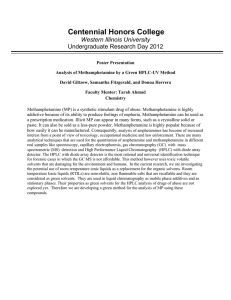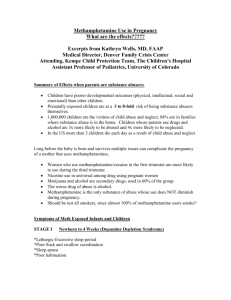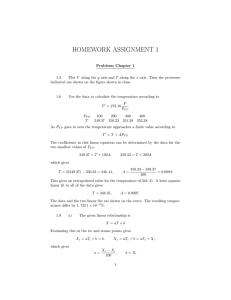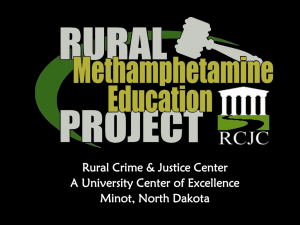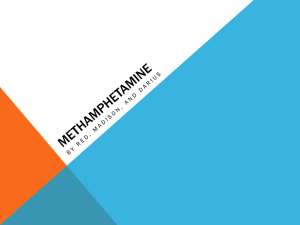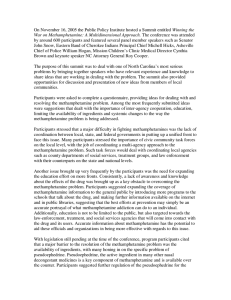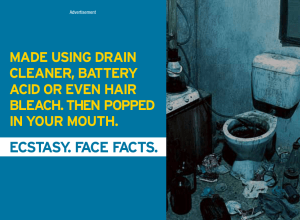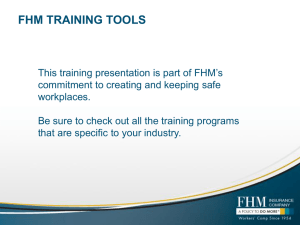Global SMART Update - United Nations Office on Drugs and Crime
advertisement
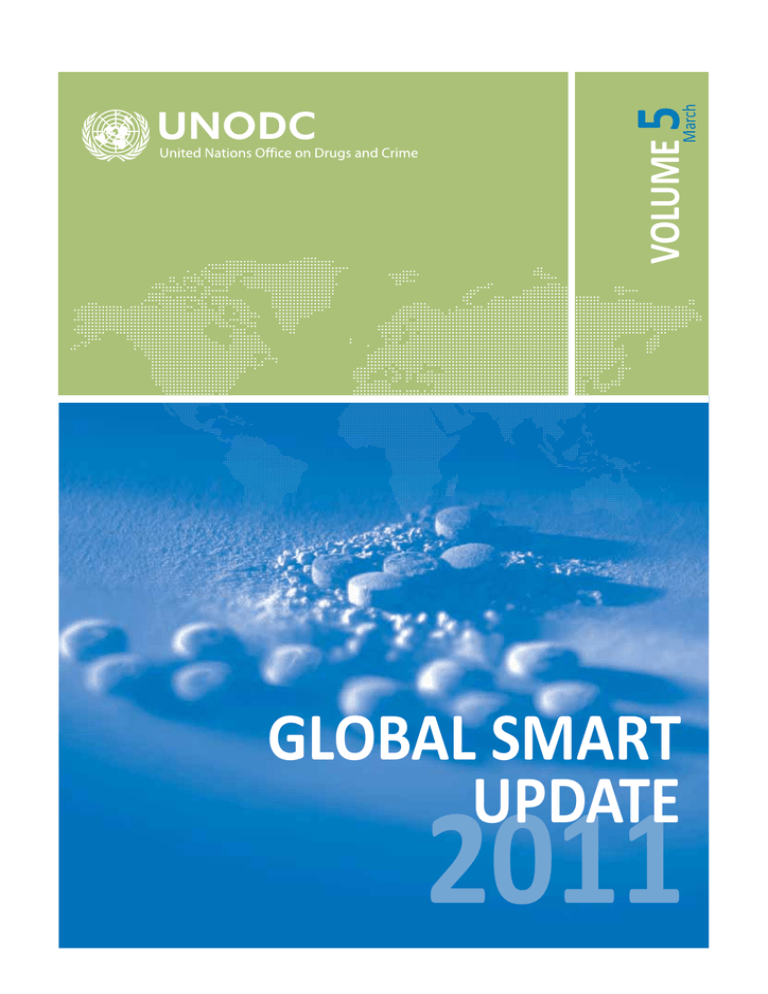
VOLUMEMarch 5 GLOBAL SMART UPDATE 2011 About the SMART Update In this issue The threat of synthec drugs is one of the most significant drug problems worldwide. Global esmates of past-year amphetamine-type smulants users (ATS) exceed those for heroin and cocaine, combined. Since 1990, ATS illicit manufacture has been reported from more than 65 countries and the figure keeps rising. Trends on the synthec drug market evolve quickly each year. Each issue of the Update contains special coverage and themac segments. In its first issue, the Update highlighted new incidents of illicit manufacture in Lan America. In the second issue, the Update focused on new types of synthec drugs and their precursor chemicals, which are oen specifically engineered to circumvent internaonal and naonal controls by subtle medicaon to the chemistry. The third issue of the Update illustrated the environmentally-friendly approaches to the disposal of safrole-rich oils which are a natural source of the precursor required in the illicit manufacture of ecstasy. The UNODC Global Synthecs Monitoring: Analyses, Reporng and Trends (SMART) Programme enhances the capacity of Member States in priority regions to generate, manage, analyse, report and use synthec drug informaon to design effecve policy and programme intervenons. Global SMART was launched in September 2008 and provides capacity-building to 11 countries in East and SouthEast Asia. In January 2011, operaons expanded into the Americas. For the Pacific, a review of ATS situaon was conducted in selected Pacific Island countries and territories. The Global SMART Update is designed to provide regular brief reporng on emerging paerns and trends of the fast changing global synthec drug situaon. Given the speed at which changes in the ATS markets occur, it is especially important to have a simple sustainable mechanism for frequent informaon sharing from different parts of the world. The biannual report is published in March and October and is available in English and Spanish. The Update reports synthec drug informaon in several categories, such as significant or unusual drug or precursor chemical seizures, new locaons or methods for clandesne manufacture, new trafficking groups or routes, changes in legislaon to address the problem of synthec drugs, environmental impact from their illicit manufacture and destrucon, emerging drugs or user groups, and health implicaons related to their use.* As of the fourth issue of the Update (October 2010), the special segment has been enlarged to provide a more in-depth review of an issue that deserves parcular aenon. In addion, short regional overviews were added to provide snapshots of the situaon in the regions of the world. Since 2010, the Update has been available in English and Spanish. The special segment of the current issue concerns South Asia, a region which has tradionally been associated with opiates, not synthec drugs. However, over the past years, the region has emerged as a source for ATS and the precursors needed to manufacture them. Traffickers increasingly go to South Asia to obtain ephedrine and pseudoephedrine, the two key precursors used in the illicit manufacture of methamphetamine. Ketamine, a hallucinogenic substance is also frequently trafficked from the region. While informaon on law enforcement acvies is oen abundant, informaon about the demand for ATS is oen scarce and anecdotal in nature. Nevertheless, the Update connues to make a determined effort to highlight the human toll of ATS use. Various demand-related subjects are covered in this issue, including facts that have come to light about the use of synthec drugs in Australia, China, Chile and the United States. * The informaon and data contained within this report are from official Government reports, press releases, scienfic journals or incidents confirmed by UNODC Field Offices. Addional or updated informaon from previously reported incidents may also be included where appropriate. Informaon denoted with an asterisk (*) are from ‘open sources’ where UNODC is waing for official confirmaon and therefore should be considered only preliminary. This report has not been formally edited. The contents of this publicaon do not necessarily reflect the views or policies of UNODC or contributory organizaons and neither do they imply any endorsement. Suggested citaon: Global SMART Update Volume 5, March 2011. Regional overviews This secon provides a short overview on the current situaon and what might be new from a key regions perspecve. The summaries begin in Oceania and East Asia, where the use of amphetamine-type smulants (ATS) is among the highest in the world, and then move westward. Oceania. Australia and New Zealand connue dismantling ATS laboratories which are oen supplied by trafficked pseudoephedrine from Asia. Lile data and informaon on ATS is available from the small Island States and territories in the Pacific. Limited data on methamphetamine use among youth show high rates in some communies (e.g. American Samoa, Guam, Marshall Islands, Palau), indicang ATS availability. East and South-East Asia. East and South-East Asia remains the region with the greatest numbers of past year amphetamine users, currently esmated at between 3.4 and 20.7 million. Methamphetamine pill seizures for 2009 were at some of the highest levels ever recorded and prelimiary data for 2010 suggests that this trend connued. Crystalline methamphetamine connues to arrive via Iranian couriers to various countries in the region. West Africa has also emerged as a source for crystalline methamphetamine trafficked to East Asia, parcularly Japan. South Asia. South Asia connues to be targeted by organized crime groups as a source for ATS precursors. Illicit methamphetamine manufacturing sites are uncovered at regular intervals. Significant amounts of ketamine are trafficked to other parts of Asia and to other countries, e.g. Canada. Very lile informaon connues to be available on the prevalence of ATS use in South Asia. West Asia and the Middle East. Countries in this region (e.g. Jordan, Saudi Arabia) report significant seizures of amphetamine pills, oen sold as Captagon. Informaon flow from the region, parcularly related to drug use in the Middle East and others, remains inadequate. Europe. New psychoacve substances appear on the illicit drug markets. Mephedrone, one of these substances, was banned in all 27 European Union Member States in December 2010. Recent data from countries in the North of Europe show that amphetamine could be increasingly replaced by methamphetamine on the markets of some Scandinavian and Balc countries. While survey data show a relavely low prevalence of amphetamines use in most European countries, in some countries, it is esmated that more than 2 percent of young people between the ages of 15 and 34 have used the drug in the last year, according to the European Monitoring Centre Against Drugs and Drug Addicon. Africa. Africa poses one of the greatest emerging ATS threats, with the first cases of trafficking of methamphetamine from Africa dang back to mid-2008. West Africa, in parcular, has become a source of methamphetamine for markets in East Asia, notably Japan and the Republic of Korea. Traffickers oen transit European, Gulf Cooperaon Council and East African countries. Few countries in Africa have the capacity and stable governance structures to fight the drug issue. Drug trafficking has a destabilizing effect on the region and the potenal to corrode good governance. North America. The United States reports growing use of ecstasy. Currently, the main source of ecstasy on the North American market are organized crime groups in Canada, but there are indicaons that ecstasy output could be increasing from groups operang in the United States and Mexico. Methamphetamine is supplied by large operaons from Mexico. Mexico connues to make enormous efforts in addressing the illicit manufacture and trafficking of methamphetamine by organized crime groups. Central and South America. Organized crime groups connue to obtain precursor chemicals from countries throughout Lan America to connue the manufacture of methamphetamine. These groups exploit countries with lax or non-comprehensive regulaons and limited awareness. There are indicaons of increasing use of ecstasy and methamphetamine in some countries in South America, including Brazil, Chile and Colombia. Special segment - ATS in South Asia Located at the crossroads of drugs supply between the sources in South East and South West Asia, South Asia (Bangladesh, Bhutan, India, Maldives, Nepal, Sri Lanka) has tradionally been affected by illicit manufacture, trafficking and abuse of drugs, mostly opiates. Over the past few years, however, South Asia has emerged as a source for amphetamine-type smulants (ATS) and the precursors needed to manufacture them. from Myanmar are trafficked into Bangladesh, India and Nepal. The recent upsurge of methamphetamine seizures originang from Myanmar (highlighted in the Global SMART ATS situaon assessment on Myanmar) may therefore be felt acutely in the region. Ketamine, a hallucinogenic substance, is also frequently trafficked in the region, parcularly from India. Seizures of ketamine in India have increased from 60 kg in 2005 to more than 1000 kg in 2009. Ketamine has also been trafficked to countries in East and South-East Asia or Canada. Quantity (kg) Manufacture. The geographical proximity to East and Southeast Asian source countries of illicit methamphetamine is one of several factors which makes South Asia a vulnerable target for illicit manufacture of Seizures of ketamine in India (2005-2009) amphetamine-type smulants. The first clandesne 1,200 ATS manufacture operaon 1,000 was detected in India in May 2003. Since then, several ad800 dional facilies have been 600 uncovered between 2004 and 2010. In August 2010, a meth400 amphetamine laboratory was 200 discovered in India. However, aempts at illicit ATS manu0 2005 2006 2007 2008 2009 facture are not just limited to India, they have also been reported from Bangladesh and Source: Directorate of Revenue Intelligence and Narcocs Control Board India Sri Lanka. In Sri Lanka, for example, a large-scale methamphetamine laboratory was dismantled in May 2008. Data situaon. Official stascs only parally reflect the situaon as comprehensive assessments to determine the nature and extent of the ATS situaon Precursor chemicals. South Asia has become one of the main regions have not been made. There is no systemac profiling used by drug traffickers to obtain ephedrine and of ATS seizures with respect to their constuents, pseudoephedrine for the illicit manufacture of markings or colour nor idenficaons or backtrack methamphetamine. India is one of the world’s invesgaons to idenfy the origin of precursors and largest manufacturers of precursor chemicals and equipment. Bangladesh also has a growing chemical industry. Despite efforts to control precursor chemicals, both Use. The lack of data also affects the drug use situaon. countries have been idenfied in a number of cases Methamphetamine and ecstasy are believed to be used as the source of diverted precursor chemicals for a in the major metropolitan areas but reports are largely range of drugs, including methamphetamine. Several anecdotal in nature. The true extent and paerns of significant seizures of pseudoephedrine in Central ATS use in the subregion is largely unknown due to the America and the Caribbean (Dominican Republic, absence of mely and representave data, parcularly Guatemala, Honduras) are believed to have originated among youth which is generally one of the most in Bangladesh. Many countries in Central America and vulnerable groups to drug use. In fact, the only general the Caribbean are vulnerable as desnaons for these populaon survey ever performed in the region was in shipments. Africa also remains at risk at being used by 2001 (India), however there were no quesons specific traffickers to obtain precursor chemicals. to amphetamine-type smulants. Representave school-based survey of drug use or comprehensive Trafficking. Amphetamine, methamphetamine and reporng of drug treatment data are also non-existent ecstasy have been regularly seized in South Asia over in a region housing 20% of the world’s populaon. The the past five years. Methamphetamine pills originang human toll of drug use therefore remains unknown. Regions covered in this issue 13 17 16 10 12 21 15 24 22 23 20 5 11 18 7 6 19 8 4 9 14 1 2 3 Note: The boundaries, names and designaons used herein do not imply official endorsement or acceptance by the United Naons. Global SMART segments are arranged based on regional threat. Oceania has among the highest prevalence rates for ATS use in the world, while the number of ATS users are greatest in East Asia. Therefore, the map and corresponding index of segments begins with recent events from Oceania and East Asia and then moves geographically westward. The numbered pins on the map above correspond with the index of segments below. Index of segments TAMWORTH, Australia 1 LONDON, United Kingdom 13 CANBERRA, Australia 2 SANTIAGO DE CHILE, Chile 14 BAY OF PLENTY, New Zealand 3 LONDON (Ontario), Canada 15 SINGAPORE, Republic of Singapore 4 VANCOUVER, Canada 16 BEIJING, China 5 VANCOUVER, Canada 17 NEW DELHI, India 6 CULIACÁN (Sinaloa), Mexico 18 DUBAI, United Arab Emirates 7 MEXICO D.F., Mexico 19 SEME, Nigeria 8 ATLANTA, United States 20 BIRCHLEIGH NORTH, South Africa 9 ANN ARBOR (Michigan), United States 21 BRUSSELS, Belgium 10 ALEXANDRIA (Virginia), United States 22 SOFIA, Bulgaria 11 WASHINGTON D.C., United States 23 BRATISLAVA, Slovakia 12 GWINETT COUNTY (Georgia), United States 24 GLOBAL SMART UPDATE Vol 5 (March 2011) 1 Significant seizure of ecstasy in Australia TAMWORTH, Australia – 20 December 2010. Almost AUD 20 million worth of ecstasy has been uncovered inside a van in northern New South Wales. According to the New South Wales police, the van was stopped for a random breath test. A search of the vehicle allegedly uncovered seven cardboard boxes of chemical glassware used to make drugs. A forensic examinaon resulted in the discovery of 19.5 kg of ecstasy. Two men were charged with possessing drug manufacturing apparatus and manufacturing a commercial quanty of ecstasy. 2 Australia: amphetamine use lower among students, ecstasy stable CANBERRA, Australia – 18 January 2011. The Federal Government released the findings of the 2008 Australian secondary school students’ use of tobacco, alcohol and over-the-counter and illicit substances. For amphetamine, the survey showed that among all 12- to 17-year-olds, the proporon of students using amphetamines in their lifeme in 2008 was significantly lower than the proporon found in 2005. Similarly, the proporon of all students reporng monthly use of amphetamines in 2008 was lower than the proporon found in 2005. For lifeme and past month use of ecstasy, the proporon of all students aged 12 to 17 remained stable. However, the proporon of 16- and 17year-olds reporng to have used ecstasy in the month before the survey was significantly higher (3.4 percent) in 2008 than in 2005 (2.3 percent). “Operaon Safari” results in seizures of methamphetamine in New Zealand 3 BAY OF PLENTY, New Zealand – 1 October 2010. A major six-month operaon, called Operaon Safari, resulted in the uncovering of six clandesne laboratories, the seizure of methamphetamine esmated at NZ$ 268,000 and the chemicals used in its manufacture. Ten people have been arrested and will face more numerous charges including conspiring to manufacture methamphetamine, the manufacture and supply of methamphetamine, supplying precursor ingredients used in the manufacture of methamphetamine, aempng to pervert the course of jusce, possession of firearms and receiving stolen property. Photo: New Zealand Police 4 BZP, TFMPP and mephedrone classified as controlled drugs in Singapore SINGAPORE – 12 November 2010. Effecve 15 November 2010, BZP (1-benzylpiperazine), TFMPP (3-Trifluoromethylphenylpiperazine) and mephedrone (4-methylmethcathinone) were classified as Class A controlled drugs in the First Schedule of the Misuse of Drugs Act in Singapore. BZP and TFMPP are both piperazines which are known to produce smulant and hallucinatory effects similar to ecstasy. Mephedrone is another smulant drug and is oen marketed as a substute to ‘Ecstasy’ and amphetamines. There is currently no known legimate use for these drugs in industry, research or medicine. Photo: Central Narcocs Bureau 6 GLOBAL SMART UPDATE Vol 5 (March 2011) Users of synthec drugs account for 28 percent of all registered drug users in China(*) 5 BEIJING, China – 20 January 2011. China had 432,000 registered synthec drug users by the end of 2010, accounng for 28 percent of the country’s drug abusers, according to an official of the Ministry of Public Security. The Director of the Narcocs Control Bureau of the Ministry stated that the number of people using synthec drugs has been growing in China, with 2010 seeing 118,000 more registered synthec drug users than in 2009. In recent years, China has seen rising illegal acvies related to synthec drugs use, such as methamphetamine (also known as “ice”) and ketamine. Out of the 31 provincial-level areas in the Chinese mainland, police seized more methamphetamine than heroin in 16 provincial-level areas. More than 100 kg of ketamine seized in India 6 NEW DELHI, India – 10 November 2010. Reports from the Department of Revenue Intelligence of India highlight a landmark case of ketamine trafficking from India to Canada. A Delhi-based exporter aempted to export approximately 102 kg of ketamine concealed in a container of clothing items to a Canada-based consignee. The shipment was seized in India. Based on the sharing of informaon, another consignment of 100 kg of ketamine was interdicted by the Canadian authories. Export of ketamine requires a ‘no objecon cerficate’ from the Narcocs Commissioner of India. Ketamine is a hallucinogenic substance not controlled by the United Naons drug control treaes. Dubai Customs detects shipment of methamphetamine 7 DUBAI, United Arab Emirates – 8 December 2010. A team of Dubai Customs inspectors detected 113 kg of crystal methamphetamine. The drug was carefully hidden in a cargo shipment said to originate from the Islamic Republic of Iran. The final desnaon of the shipment was Malaysia. Authories exchanged informaon about the seized shipment with the concerned authories in Malaysia and Singapore where the shipment was planned to transit aer moving from Dubai. Joint cooperaon between Dubai and the related authories of the two countries led to the seizure of the shipment in Kuala Lumpur Airport and the receiver of the shipment was caught. Photo: Dubai Customs Methamphetamine trafficker arrested in Nigeria Photo:NDLEA 7 8 SEME, Nigeria – 3 January 2011. In a renewed offensive by operaves of the Naonal Drug Law Enforcement Agency (NDLEA) of Nigeria, a 27-year old man was intercepted by the Seme Border Command with more than 2.5 kg of methamphetamine. The suspected drug trafficker was arrested at Gbaji check point along the Lagos-Badagry expressway. The methamphetamine was hidden in a false boom compartment of his luggage. The suspect intended to travel to Indonesia via Ghana. GLOBAL SMART UPDATE Vol 5 (March 2011) 9 Methamphetamine laboratory discovered in South Africa BIRCHLEIGH NORTH, South Africa – 24 November 2010. The South African Police Service discovered a drug manufacturing laboratory worth in a residenal area in Birchleigh North in Kempton Park (near Johannesburg), following an intensive invesgaon. Chemicals such as ephedrine, iodine and hydrochloric acid worth an esmated ZAR 26 million were found in large quanes. Methamphetamine worth an esmated ZAR 14 million was also found. 10 EU-wide ban on mephedrone BRUSSELS, Belgium – 3 December 2010. The Jusce Ministers of the European Union Member States agreed to ban mephedrone (4-methylmethcathinone), a substance oen sold as “legal alternave to ecstasy”. The decision bans the manufacturing and the markeng of mephedrone, subming it to criminal sancons. Mephedrone is a smulant whose physical effects are comparable to those produced by ecstasy (MDMA) or cocaine. A scienfic risk assessment carried out by the European Monitoring Centre on Drugs and Drug Addicon (EMCDDA) showed that mephedrone can cause acute health problems. Photo: Talk to Frank, UK Amphetamine laboratory discovered in Bulgaria 11 SOFIA, Bulgaria – 15 January 2010. Following a specialized police operaon, officials discovered an illicit amphetamine-manufacturing laboratory. The facility located on the outskirts of Sofia. Law enforcement authories discovered and seized laboratory equipment for the synthesis of drugs, the precursor 1-phenyl-2-propanone and chemicals required for the chemical process. One person was arrested. The producon capacity of the laboratory was esmated at approximately 3 kg amphetamine. Photo: Ministry of Interior 12 ‘Masked’ PMK seized by law enforcement authories in the Slovak Republic BRATISLAVA, Slovakia – 15 October 2010. Customs Officers, in collaboraon with invesgators of KR PZ Braslava, confiscated 4 drums of 200 kg weight containing a mixture of chemicals PMK (3,4Methylenedioxyphenyl-2-propanone), piperonal and PMK-glycidate. This parcular mixture was last found in Europe in the Netherlands in May 2010 in a clandesne laboratory for the manufacture of ecstasy and methamphetamine, along with instrucons for the conversion to PMK. According to preliminary findings, the total weight of the 200 kg seized drug precursor mixture could have resulted in the manufacture of about 113 liters PMK, which could have produced more than 1 million Ecstasy tablets. 8 GLOBAL SMART UPDATE Vol 5 (March 2011) UK bans import of 2-DPMP 13 LONDON, United Kingdom – 4 November 2010. The United Kingdom banned the importaon of a drug found in some samples of socalled “legal high” Ivory Wave. The importaon ban on 2-DPMP (2-diphenylmethylpiperidine) follows advice from the Advisory Council on the Misuse of Drugs which recommended the move to cut the supply of this potenally harmful substance and stop it from gaining a foothold in the United Kingdom. Chile: more posive tests for methamphetamine use in arrestees 14 SANTIAGO DE CHILE, Chile – 18 November 2010. Between 2005 and 2010, the number of arrestees tesng posive for methamphetamine increased from 1,5 per cent to 12,3 percent, according to a study presented by the Fundación Paz Ciudadana. The data provides an important perspecve into the part of the populaon not readily accessed through populaon surveys. Photo: DEA Canada: three men charged with diversion of ephedrine 15 LONDON (Ontario), Canada – 5 November 2010. About 550 kg of ephedrine were seized by the Royal Canadian Mounted Police (RCMP) in London, Ontario. The seizures were the result of a long-term invesgaon known as Project OVICE, an invesgaon targeng the large-scale diversion of precursor chemicals by organized crime groups involved in the illicit manufacturing of methamphetamine. Three men were charged with conspiracy to commit and aempt to divert ephedrine. One of the three men was also charged with the unlawful import of 800 kg of GBL (gamma-butyrolactone). More than 6 mt of precursor P2P seized in Canada Photo: RCMP 9 16 VANCOUVER, Canada – 24 November 2010. More than 6 mt of the precursor chemical P2P (1-Phenyl-2-propanone) have been seized in the latest joint operaon between the Canada Border Services Agency (CBSA) and Royal Canadian Mounted Police (RCMP). In October 2010, CBSA idenfied a suspicious shipment coming into Vancouver from China, and the container was referred for inspecon. While the container’s documentaon idenfied the shipment as “footwear”, during their examinaon, CBSA officers uncovered 150 boxes hidden within the load that each contained a 22-kilo jug of suspected P2P. P2P is a precursor used primarily in the manufacture of methamphetamine. GLOBAL SMART UPDATE Vol 5 (March 2011) 17 Canada reports record seizure of ketamine VANCOUVER, Canada – 7 December 2010. The Canada Border Service Agency and the RCMP Drug Enforcement Program have combined forces to charge five people in the largest ketamine seizure in Canadian history. Canada Border Services Officers idenfied a suspicious shipment onboard a container vessel arriving from Hong Kong, Special Administrave Region of China. Documentaon accompanying the shipment idenfied the goods as 402 cartons of coffee mugs. Upon inspecon, however, a white crystalline powder was found. Tests indicated that the bags contained ketamine hydrochloride. A total of 1003.9 kg of ketamine was seized. Photo: RCMP, CBSA Underground deposit of chemicals discovered in Mexico 18 CULIACÁN (Sinaloa), Mexico – 16 December 2010. Military personal have found an underground depot for chemicals used in the illicit manufacture of synthec drugs. It is believed that the substances found in the depot were intended to be delivered to the illicit drug laboratory which was discovered by authories in October 2010 where several substances, including liquid methamphetamine, acetone and toluene were found. Photo: SEDENA 19 Seizure of methamphetamine precursor in Mexico MEXICO D.F., Mexico – 16 December 2010. As a result of a joint operaon, 240 drums with a capacity of 200 litres each of methylamine, a precursor for methamphetamine manufacture, were confiscated. The said chemical was le abandoned in an industrial zone in Altamira in the state of Tamaulipas. No informaon was immediately available about the final desnaon of the product which has not been claimed by its owner. Photo: Secretaría de la Marina 20 One of the largest ecstasy pill seizures in United States history ATLANTA, United States – 1 October 2010. Pursuant to a search warrant, law enforcement officers seized approximately 700,000 tablets of ecstasy in one of the largest seizures of this substance in the history of the United States. The tablets were seized in a house in Chamble, Georgia, where they were hidden in various places, including the insulaon of the walls and in a crawl space near a bedroom. The street value of the ecstasy is esmated at $2.8 million. 10 GLOBAL SMART UPDATE Vol 5 (March 2011) Ecstasy use on the rise in the United States Use % who used in last 12 months 10 8 8th Grade 10th Grade 12th Grade Percent 6 21 ANN ARBOR (Michigan), United States – 14 December 2010. Results of the 2010 Monitoring the Future Survey indicate a surge in the use of ecstasy. Ecstasy use among teens rose sharply in the late 1990s, peaked in 2001, and then fell just as sharply over the next four years or so as perceived risk rose considerably. Perceived risk is defined as the proporon of teens that see great risk to the user from using ecstasy even once or twice. Aer 2004 or 2005, perceived risk fell steadily and the invesgators warned that this could lead to a rebound in use. Some of that rebound now appears to be taking place, as use rose this year in all three grades, significantly so for 8th and 10th grades. 4 2 0 '74 '76 '78 '80 '82 '84 '86 '88 '90 '92 '94 '96 '98 '00 '02 '04 '06 '08 '10 YEAR Source: Monitoring the Future Study Man pleads guilty to brokering pseudoephedrine transacons 22 Photo: DEA ALEXANDRIA (Virginia), United States – 1 December 2010. One man pleaded guilty to brokering large amounts of pseudoephedrine from India to Mexico and Guatemala. He faces a maximum penalty of 10 years in prison. According to court documents, the broker conspired with others to obtain large quanes of pseudoephedrine – a chemical used to manufacture methamphetamine- from India for illegal export to Mexico and Guatemala. The man admied in court that in 2008 and 2009, he worked with an Indian supplier of pseudoephedrine to broker the shipments. In June 2009, law enforcement authories seized one of these shipments in Puerto Quetzal, Guatemala, which contained 17.5 million tablets. United States drug czar warning against smulants masquerading as ‘bath salts’ 23 WASHINGTON D.C., United States – 1 February 2011. The Director of the United States Office of Naonal Drug Control Policy, Gil Kerlikowske, released a statement expressing deep concern “about the distribuon, sale and use of synthec smulants – especially those that are marketed as legal substances. Although we lack sufficient data to understand exactly how prevalent the use of these smulants are, we know they pose a serious threat to the health and well-being of young people and anyone who may use them. At a me when drug use in America is increasing, the markeng and sale of these poisons as “bath salts” is both unacceptable and dangerous.” Recent informaon from poison control centres suggests that the use of these substances is on the rise. Large methamphetamine seizure in the United States 24 GWINETT COUNTY (Georgia), United States – 29 November 2010. The search of a house in Norcross by invesgators with the Gwinne County Police Department resulted in a significant seizure of methamphetamine. Invesgators confiscated a combined total of 447 kg of methamphetamine with an esmated street value of almost $ 45m. This is believed to be one of the largest methamphetamine seizures in the United States. One person is in custody. Photo: DEA 11 t t t t t t t t t t produced the March and October Global SMART Updates (in English and Spanish); presented the latest informaon related to the global ATS situaon at the 53rd Commission on Narcoc Drugs in Vienna; convened the second annual Global SMART Programme Advisory Group meeng; provided substanve input into the 2010 World Drug Report chapter on ATS; conducted the second annual regional synthec drug informaon workshops in East and South-East Asia; iniated and completed recruitment for Global SMART expansion into the Americas in partnership with the Organizaon of American States (OAS); reviewed the ATS situaon in selected Pacific Islands countries and territories; redesigned Asia and Pacific ATS Informaon Centre (APAIC) website and connued development of the Drug Abuse Informaon Network for Asia and the Pacific (DAINAP) and the on-line Forensic Alert; disseminated informaon related to the synthec drug situaon at targeted conferences; prepared the second annual regional report on the paerns and trends of amphetaminetype smulants (see below). Recent Global SMART Publicaons 2010 Paerns and trends of amphetamine-type smulants and other drugs - Asia and the Pacific (November 2010) The report provides detailed data and informaon on 15 countries in East and South-East Asia, with regional coverage of South Asia and Oceania. The report examines the threat from the illicit manufacture, trafficking and use of ATS from within the region and from neighbouring regions. The current report has expanded coverage of trafficking routes for both drugs and precursor chemicals, reporng on drug trafficking organizaons, and improved forensic informaon. Myanmar - Situaon assessment on amphetamine-type smulants (December 2010) The report illustrates the situaon with respect to the illicit manufacture trafficking and use of ATS in Myanmar. Over the past decade, Myanmar has become a key producer of ATS pills in the region, parcularly methamphetamine pills. UNODC would like to specifically recognize the following funding partners for their investment in the Global SMART Programme. UNODC would also like to acknowledge the significant contribuons of our partner the Global SMART Americas, the Inter-American Drug Abuse Control Commission (CICAD), for their support regarding this publicaon. Australia Canada Japan New Zealand Korea, Rep. Thailand The Global SMART Programme is managed by the Laboratory and Scienfic Secon of the Division for Policy and Analysis and Public Affairs. UNODC reiterates its appreciaon and gratude to Members States and partner agencies for the reports and informaon that provided the basis of this report. If you have comments on this report, or would like to contribute informaon that should be considered for future reports, please contact the Global SMART Programme at globalsmart@unodc.org. Informaon on the Global SMART Programme can be found via the internet at www.unodc.org and www.apaic.org or by contacng UNODC at the Vienna Internaonal Centre, P.O. Box 500, A-1400, Vienna, Austria. 17 18 Global SMART accomplishments for 2010 The Global SMART (Synthecs Monitoring: Analyses, Reporng and Trends) Programme improves the capacity of targeted Member States to generate, manage, analyze, report and use informaon on illicit synthec drugs. The programme launched formal operaons in September 2008 in Bangkok. In 2010, the Global SMART Programme:
